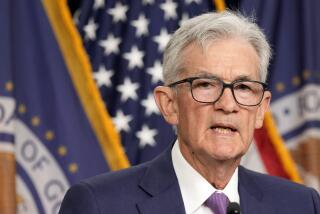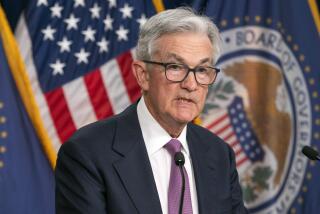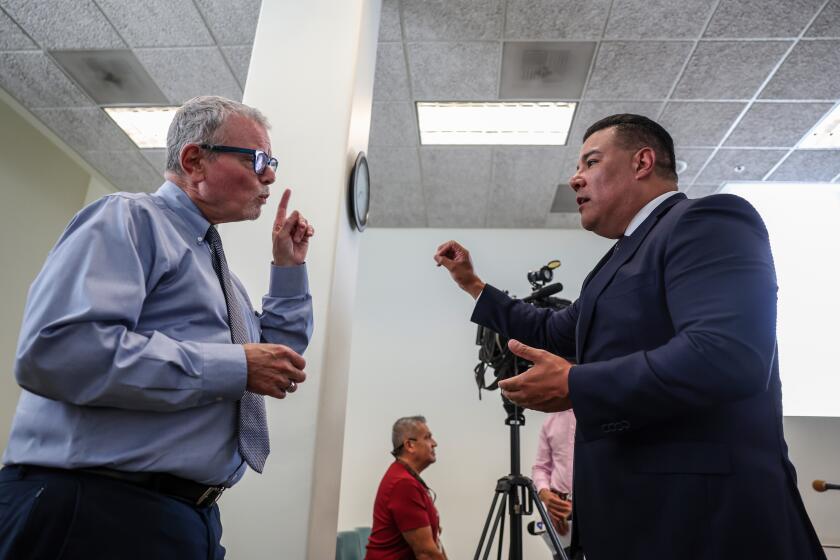Fed holds steady — for now
WASHINGTON — Federal Reserve Chairman Ben S. Bernanke sent the first signals that with an improving economy and labor market, the central bank stood ready to ratchet back its massive stimulus effort gradually before completely pulling the plug on it.
For now, Bernanke and his colleagues at the Fed said Wednesday that they will continue with their program to buy $85 billion in bonds every month.
The stimulus is aimed at lowering long-term interest rates to spur investment and spending, but there has been growing concern in and outside the central bank that the Fed’s easy-money policies are causing asset bubbles and will lead to higher inflation.
Fed policymakers, in a statement after their two-day meeting ended Wednesday, reaffirmed that they will maintain the bond purchases until there is “substantial improvement” in the labor market.
Bernanke did not elaborate on what would constitute substantial, but he made clear that the recent gains were not enough to stop the stimulus efforts, which also include keeping short-term interest rates near zero.
“We’ll need to see sustained improvement. One month, two months, doesn’t cut it,” he said in a news conference shortly after the release of the Fed statement.
Bernanke said he was mindful about concerns that the Fed stimulus was “not unnecessarily encouraging excessive risk taking or other problems in the financial markets,” but stated that the Fed committee regarded the costs as “manageable.”
“I thought his smile in response to a question on whether it was too late to get in on the stock market rally says it all,” said Chris Rupkey, chief financial economist at the Bank of Tokyo-Mitsubishi in New York. “The Fed is happy with the way things are going. If it’s not broken, don’t fix it.”
Still, Rupkey and other economists agreed that the Fed was likely to reduce the amount of its monthly bond purchases, given the recent and expected growth in the economy.
The economy added a healthy 236,000 net jobs in February and the nation’s unemployment rate fell to 7.7%, the lowest level since the end of 2008. What’s more, a series of upbeat economic data since the Fed’s last meeting in January — on the housing market, retail sales and manufacturing output — has suggested that the recovery is gaining momentum.
Bernard Baumohl, chief global economist at the Economic Outlook Group, said he believed that Fed policymakers will begin considering pulling back on the bond purchases as soon as their June meeting.
“The groundwork has been set now,” Baumohl said. “It’s an idea that’s going to be part of a discussion on Wall Street that the Fed is beginning to contemplate, if the economy continues to improve, it will be scaling back soon.”
Bernanke talked extensively at his quarterly news conference about how the Fed might start rolling back its efforts.
“When we see that the … situation has changed in a meaningful way, then we may well adjust the pace of purchases,” he said.
The Fed would look at a range of labor market indicators, including the unemployment rate and weekly jobless claims, before making any changes. And if the Fed did reduce its monthly bond purchases, Bernanke indicated that it would be prepared to increase the level back to $85 billion if conditions started to worsen.
“The point of this is to let the market see our behavior; to let them see how we respond to changes in the outlook,” Bernanke said. “And that way, there’ll be a better ability, I hope, for the markets to anticipate either a return to higher levels of purchases or the ultimate phasing-out of the program.”
Bernanke noted that private-sector payrolls have been growing an average of 200,000 jobs a month over the last five months, the unemployment rate has dropped 0.4 percentage points since September and weekly jobless claims have recently been at their lowest level since before the financial crisis.
But he also said some earlier improvements in the labor market have been short-lived as the economy has struggled to recover from the Great Recession.
The Fed statement, though, did acknowledge the strengthening economy, saying it had returned to “moderate” growth after slowing late last year.
Fed officials also said that “fiscal policy has become somewhat more restrictive,” a reference to the higher payroll taxes for workers at the start of this year and the automatic government spending cuts that began this month under the so-called sequestration.
In its latest quarterly outlook, the Fed said the economy would expand 2.3% to 2.8% this year, down from a projected maximum of 3% in its forecast made in December. Economic growth would accelerate to 2.9% to 3.4% next year and rise to as much as 3.7% in 2015, it said.
At the same time, the Fed lowered its projection for the unemployment rate, saying it would range from 7.3% to 7.5% by the fourth quarter of this year. The forecast in December was 7.4% to 7.7%.
Policymakers repeated that they would keep the Fed’s key short-term interest rate at rock bottom as long as the jobless rate was above 6.5% and the inflation outlook remained close to its target rate of 2%. Most Fed officials predict that the unemployment rate will not drop to 6.5% until 2015.
The Fed said Wednesday that inflation still was running “somewhat below” its longer-term objective, though it mentioned “temporary variations that largely reflect fluctuations in energy prices.”
In their forecast, most Fed officials predicted that inflation would remain at or below the 2% target this year and next, with the measure of core consumer prices coming in at 1.8% to 2.1% in 2015.
Bernanke’s second term as Fed chairman expires next January, and that has fueled speculation about whether he might seek to stay on another term to lead what many expect to be a tricky withdrawal or exit of the central bank’s stimulus policies.
Asked whether he had talked with President Obama about his future, Bernanke replied: “I’ve spoken to the president a bit, but I really don’t have any information for you at this juncture. I don’t think I’m the only person in the world who can manage the exit.”
More to Read
Inside the business of entertainment
The Wide Shot brings you news, analysis and insights on everything from streaming wars to production — and what it all means for the future.
You may occasionally receive promotional content from the Los Angeles Times.












